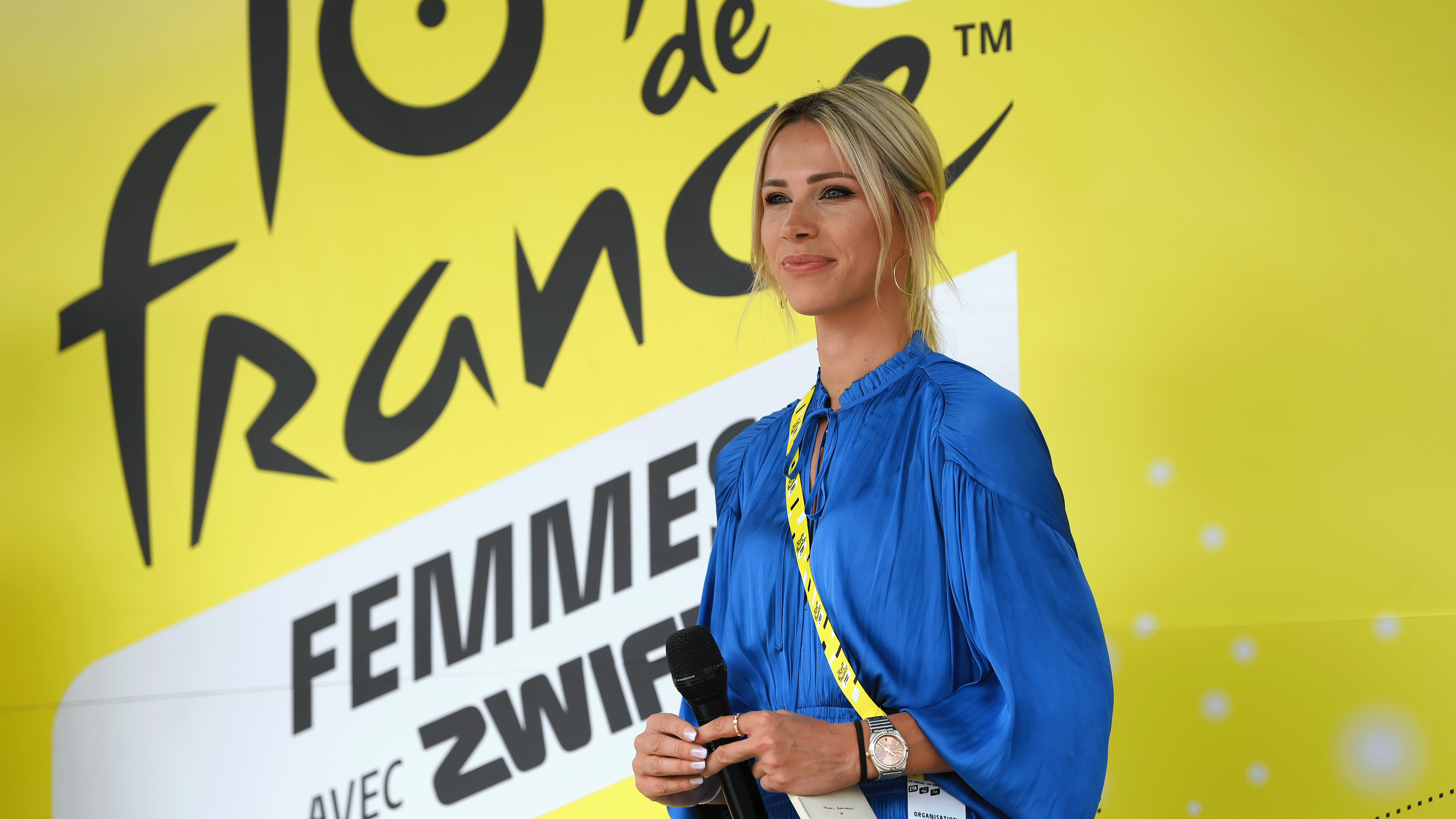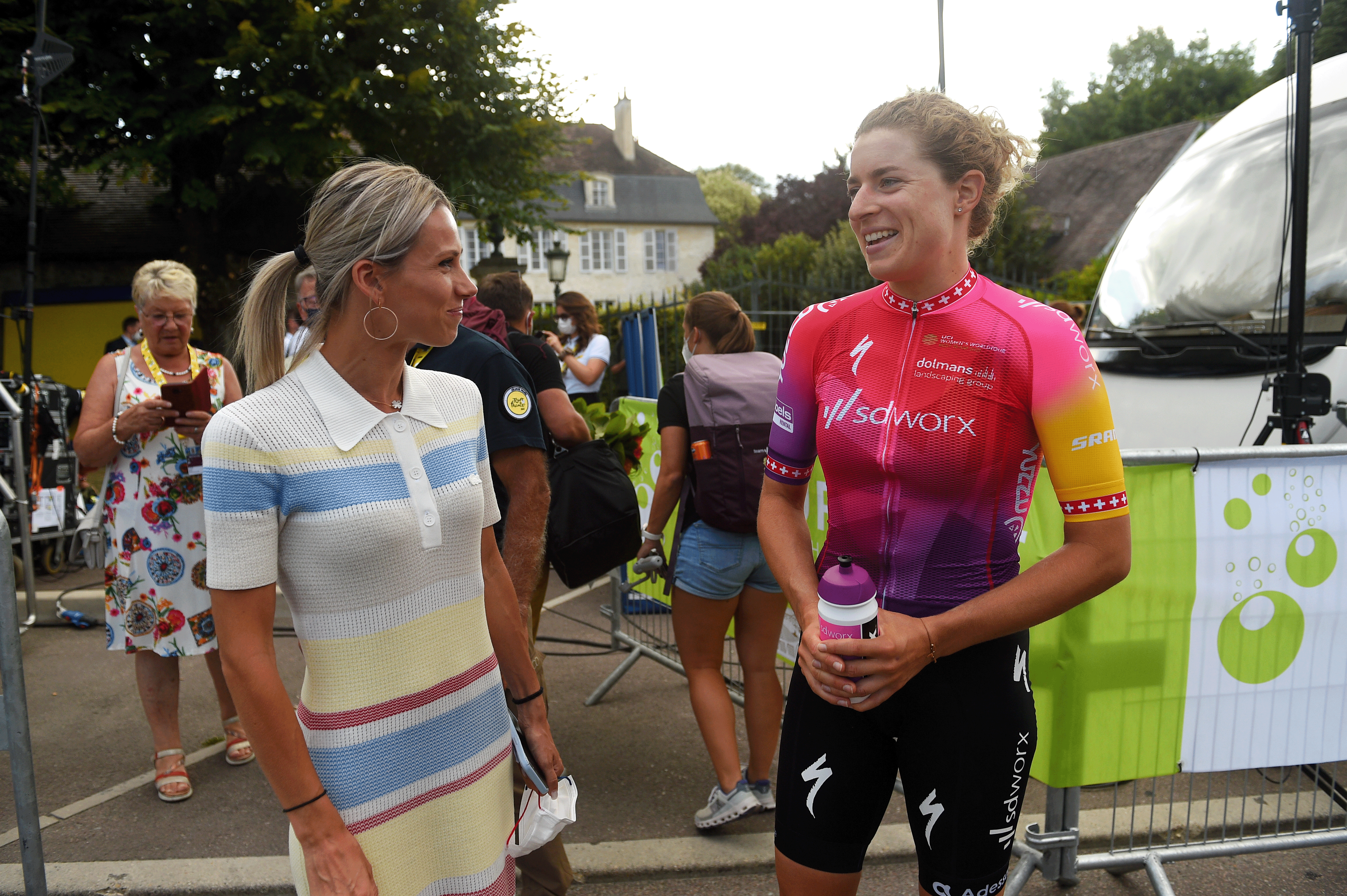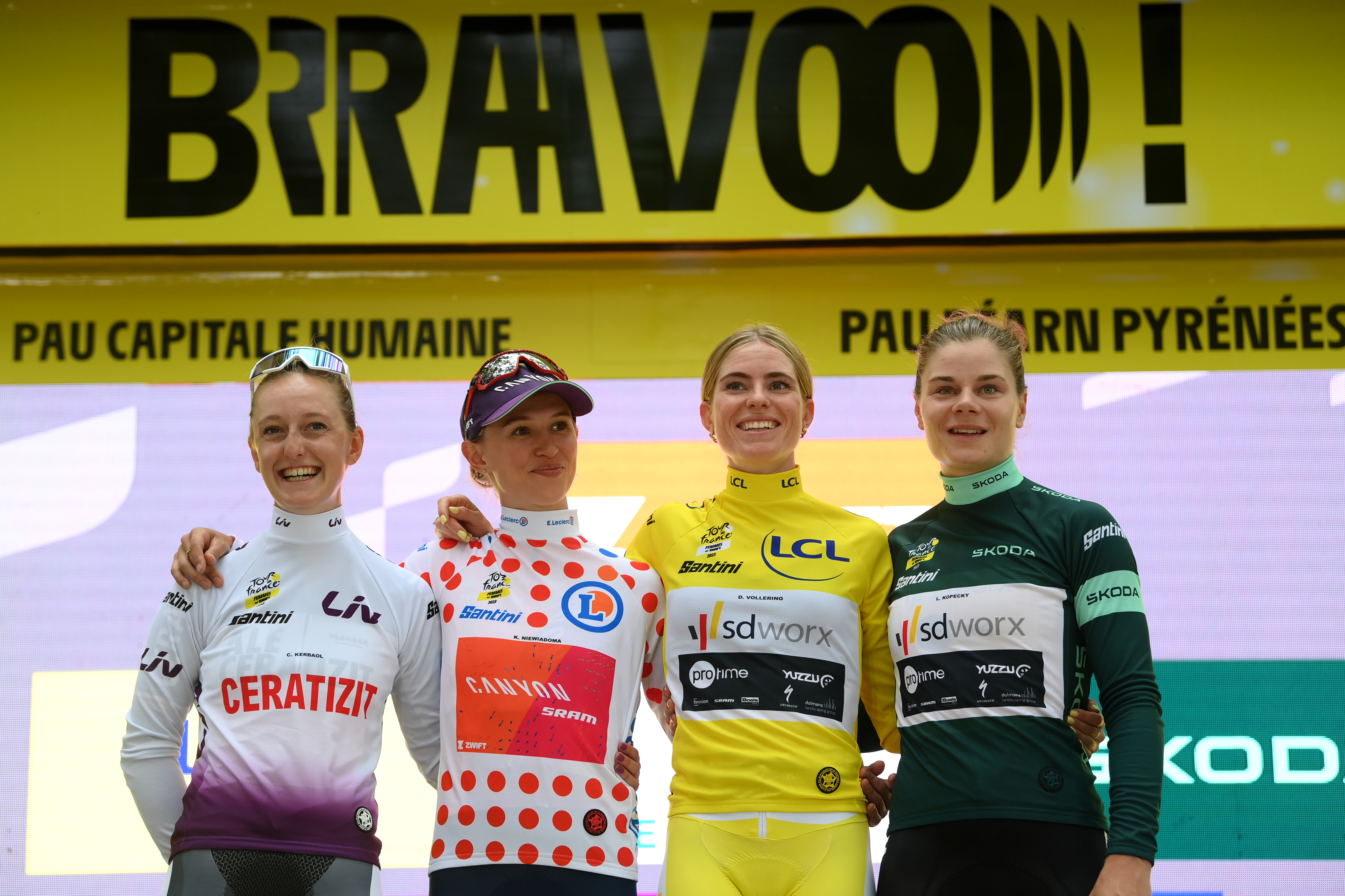
“We’ve been at it all year with the preparation, and we’re just finishing the final details,” announces Marion Rousse as she speaks to me from a taxi en route to another interview at a radio station. Representing Tour de France Femmes race organisers Amaury Sport Organisation (ASO), she’s been doing the rounds with the various stakeholders to promote the event and engage various organisations and sponsors for ASO’s flagship women’s event.
Now in its third year of the revived women’s grande boucle, Rousse is keen to keep up the momentum in making this the women’s professional race of reference, and more than just a race in France, but a cultural event like the men’s race has become over its 121-year existence.
“In the first edition of Le Tour de France Femmes avec Zwift, we included La Planche des Belles Filles, as the Vosges were the first mountains crested in the history of the Tour de France," says Rousse. “We want to gradually build on the Tour’s history, and last year we included the Col d’Aspin, and the Tourmalet – the most visited climb in the Tour de France.”
This year’s edition will end on a high in more ways than one with the finale being at the summit of the fabled Alpe d’Huez, a climb that first featured in the men's race in 1952 and has been rarely seen in women's cycling.
“Well, the legend of the Tour de France is often written in its mountain passes,” says the Frenchwoman. “So it doesn’t get better than Alpe d’Huez – a climb known throughout the world, and with its 21 numbered bends, has been a dramatic stage in the men’s Tour. Of course, the winner will have her name written on one of the bends.”
Part of developing the history of the Tour de France Femmes lies in including parallel themes – such as with the Vosges, the Tourmalet, and Alpe d’Huez. Furthermore, the venue for the Grand Depart wasn’t a random choice.
The first overseas start of the Tour de France took place from the Netherlands – Amsterdam 70 years ago. Rousse explained that the city of Rotterdam had applied to host the Grand Depart, and for her and her team, it seemed fitting to hold the event there.
“We like the parallels between the Tour de France and the Tour de France Femmes with Zwift, and it seemed right to have our first-ever foreign Grand Depart in the Netherlands, an excellent country for cycling,” she says. “It’s also a country that has been at the forefront in the development of women’s cycling. We have had a number of women’s champions from the Netherlands. So it’s an honour for us to be able to start the Tour from this country.”
Note that this interweaving of men's and women's Tour de France races works both ways. The inaugural edition of the Tour de France Femmes in 2022 included the famous “chemins blancs” through the Champagne region on the stage between Troyes and Bar-sur-Aube, while this year’s men's Tour de France peloton got to enjoy the gravelly roads for the first time during Stage 9, starting and finishing in Troyes. Although the routes weren’t identical, both stages had their share of carnage on the stone-strewn rough roads, and both races had unexpected winners in the shape of Marlen Reusser and Anthony Turgis, respectively.

One feature in this year’s Tour de France Femmes, which has been present in men's Tours de France gone by, is a two-stage day. Day Two, which features a 67km road race, followed by a 6.3km individual time trial, was exceptionally permitted by the Union Cycliste Internationale (UCI) given how calendars have had to be rejigged during this Olympic year.
Rousse explains: “This is a different kind of year because of the Olympics, so finding a date was not easy. We wanted to still be able to hold the Tour de France Femmes avec Zwift during the summer holidays so that more people could watch it. At the same time, we still wanted to have eight stages, so to do this, we decided on this date in August, but we had to get exceptional authorisation from the UCI to hold two stages in one day. Having the 67km road race, and then the short time trial could attract more spectators and create a bit of suspense among the Dutch audience.”
Since the inaugural edition of the Tour de France Femmes in 2022, the former French Road racing champion has seen how women’s racing has developed both in the conversations and interest around women’s racing, as well as the level of the racing.
“Even at the first edition of the Tour, we had lots of spectators on the roadside,” Rousse says. “But what we now see is that spectators have begun to recognise the riders and know the names of the top contenders. People begin to speak more about specific riders they like or identify with. I’ve also noticed changes in the questions from the journalists,” Rousse says.
“In the first edition, the questions were more around whether it’s a good thing to have a women’s Tour de France. Whereas in the second edition, they were asking about the favourites to win the different stages, or discussions around who the sprinters rouleurs, or climbers are – so folks can get more excited about watching the stages over the iconic routes.”
Rousse continues: “We have also noticed the change in the level of racer. In the second edition of the Tour, we saw a peloton that was more homogeneous in terms of the level compared with the previous year. We have done a lot of work with the UCI to help raise the overall level, and this is also thanks to the various sponsors who have invested in women’s cycle racing. Consequently, more and more women are better paid, better resourced and so can train better, and we are beginning to see that when you look at the race results.”
This year, the levelling up has continued, with La Vuelta Feminina and Giro d’Italia Women having racers from different teams topping the general classification - Demi Vollering (SD Worx-Protime) and Elisa Longo Borghini (Lidl-Trek). In addition, both races had an array of teams celebrating stage victories as their racers were first across the finish line, in some cases, riders from smaller teams.
The days of there being an odds-on favourite to win a race are gone, and spectators can now engage in and enjoy the suspense of who will wear the yellow, polka dot, white or green jerseys.

With these positive developments, Rousse is beginning to see the fruits of her work in organising and promoting the Tour de France Femmes with her team. The 32-year-old, who was appointed and appointed by Christian Prudhomme in 2021, has worked doggedly to make this event successful so that it doesn’t have the same fate as the original Tour de France Féminin, which ran throughout the late 1980s after a one-off race in 1955.
During that era, when the race was contested by the likes of Jeannie Longo, Maria Canins, and Connie Carpenter-Phinney, the race was run on a shoestring under the directorship of Felix Levitan and Xavier Louy and was a huge loss-making project.
As well as the nuts and bolts of organising the race, the former racer has racked up thousands of miles meeting different officials across the stage towns in France, the Netherlands and Belgium to be sure that everything is on point for the big opening day on 12th August. So where does she get her doggedness from?
Raised in a cycling family, where her father, Didier, was a first-category road racer, and her cousins Laurent and David Lefèvre, and Olivier Bonnaire raced professionally, Rousse is the younger of two girls. Even as infants, there were clear differences between them in their personalities. While Flavie was of a calm relaxed temperament, little Marion was a sparkly bundle of energy darting around, who couldn’t stay seated for long. She enjoyed running through fields and parks around her home near Valenciennes in Northern France.
Marion recalls: “My mum said when I came home from playing I’d gotten all dirty and I’ve lumps and bumps on my body. When I was very small she used to take me with her to go and watch my dad racing. Then I got fed up of watching, and wanted to have a go too.”
While Didier was not keen on the youngster starting racing, her mother secretly applied for a racing licence for her daughter. That was the debut of little Marion’s cycling career - at the age of six! Rousse learnt to juggle racing and schoolwork. Eventually, Didier recognised his daughter's desire to be a bike racer and became her coach.
As a racer for Team Vienne Futuroscope, she became the French National Road Race champion in 2012 and later joined Lotto Belisol. It was while racing that she cut her teeth in broadcasting when she was given the opportunity to do some TV commentary – another activity among the different jobs she juggled to make ends meet at a time when women’s pro-cycling salaries were comparatively lean.
Eventually, Rousse left racing to focus more on her off-the-bike activities. “I realised I had to choose between media work or racing, as I got the impression I wasn't doing either of them really well. I figured I'd already had a 20-year racing career at the age of 25, so felt ready to focus more on other things.”
Rousse grew into that role and is now a consultant for France TV. She also gained experience as an assistant race director of the Tour de Provence, and in the last couple of years has been mum to little Nino, and lives with her partner Julian Alaphilippe. Spinning a few plates has been an ongoing theme as Rousse says she’s done that since she was six.
Inspiring the next generation

Although Rousse enjoyed a successful career, competing alongside the likes of Elena Cecchini, Audrey Cordon-Ragot, Marianne Vos, and Jolien d’Hoore, she didn’t get to race in many major high-profile events like some of her former contemporaries now do. Nonetheless, the Tour de France Femmes Director is keen to focus on giving something back to the sport that has done so much for her.
“Once I have done something I tend not to look back much. My character is to move on without looking back and wishing I was doing what I used to do,” Rousse says.
“I think that the Tour de France could serve a role as to inspire little girls to have a go at racing at this level. They will switch on the TV and will see women on a bike, and they may even say to themselves ‘Well I could have a go at that too’ and they won’t pose themselves the question about whether they can do it or not. I am really happy to see the developments in women’s cycle racing.”
Of course, she recognises that there is still some way to go in terms of attitudes, but she won’t allow that to concern her too much.
“I just get on with my work without thinking whether I am a man or a woman. The best reply I can give to people who are stuck on the fact that a woman shouldn’t be on a bike is that I don’t need to explain anything to them; I will just show them – whether that’s with the Tour de France Femmes avec Zwift or anything else. We are there because we are in our well-deserved place. It’s for those people to change their opinions, rather than us needing to explain anything to them.”
Back to the Tour de France Femmes, and Rousse is looking forward to what promises to be an exciting third edition of the race, as she summarises a few of the interesting stages: “All the stages have been planned so that there is something for everyone, and the different types of rider will have their opportunity to shine.
“Stage 4 from Valkenberg to Liège could be deceptively difficult, especially when being done in August. Time gaps could definitely be formed there as the riders go over Cote de La Redoute, Cote des Forges and Cote de la Roche aux Faucons in rapid succession near the end of the stage.
“Stage 7 to Le Grand Bornand will also cause some reordering of the general classification, before the climax on Alpe d’Huez, which is preceded by the hard side of Col du Glandon. This promises to be a real battle and will be one of the hardest stages in any women’s race.
“For me, the critical success factors come in the shape of sporting success – great racing – but also with lots of people engaging in the sport, with many people smiling at the side of the road. I look forward to the folks doing that again this year.”
Get unlimited access to all of our coverage of the 2024 Tour de France Femmes - including breaking news and analysis reported by our journalists on the ground from every stage as it happens and more. Find out more.







